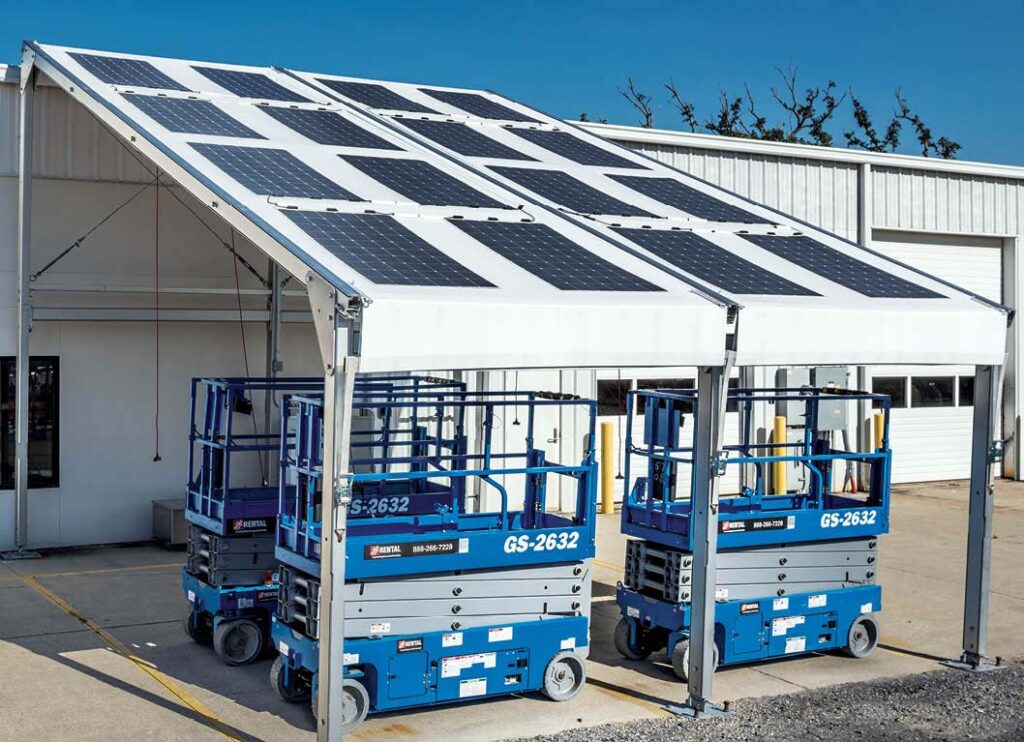
As a greener, increasingly high-tech world seeks ways to better optimize the power of the sun, textiles manufacturers are competing to be the first to offer solar-generating fabrics that combine efficient power conversion with flexibility, strength, ease of mass production and cost effectiveness.
While many effective solar fabrics are in use today, many scientists report that we’re still waiting for the advent of versions that have all the advantages needed for widespread consumer use.
Some promising versions feature a self-assembling photovoltaic (PV) crystal known as perovskite that the U.S. Department of Energy reports can perform at up to 25% efficiency. Scientists believe perovskite-based films could be available within the next decade for use on marine, tent and awning canvases as well as conventional buildings.
In promising news in December 2022, the Massachusetts Institute of Technology (MIT) announced the development of ultralight fabric solar cells that are thinner than a human hair yet durable and flexible enough to be glued to fabrics as power sources. At one-hundredth the weight of conventional solar panels, they’re reportedly able to generate 18 times more power per kilogram. And they’re produced with semiconducting inks via printing processes expected to be adaptable to large-scale manufacturing.
Could the new cells be the answer to developing the powerhouse textiles that could virtually revolutionize the industrial fabric industry? Possibly, says Dr. Jack Martin, a professor in the Department of Sustainable Technology and the Built Environment at Appalachian State University in Boone, N.C. He’s cautiously optimistic, but over the past couple decades, he’s seen the emergence of several similar discoveries that eventually fell short in one or more of the key aspects needed for true commercial viability.
“We have films of PV that can be applied to fabrics, but there are problems with dissimilar materials and adhesives,” Martin says. “What about PV within fabrics? Our preferred state would be a flexible PV—durable, long-lasting with high performance. That’s the golden dream.”
To home in on where the world stands in terms of solar fabric development, here is a progress report and survey of developments from a variety of companies devoted to solar-powered textiles.
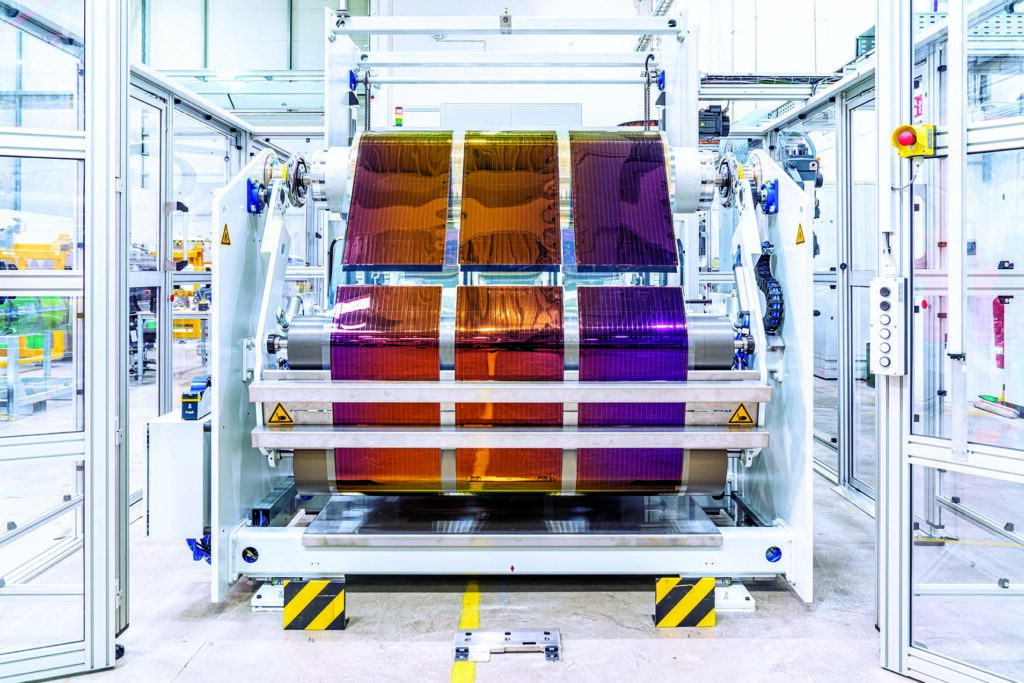
The market is “almost infinite”
German firm Heliatek reports on its product HeliaSol, an organic photovoltaic solar film that can be glued to multiple surfaces and is now marketed primarily for rooftops and facades. Rather than the more conventional silicon, its semiconductors are based on carbon-based molecules. Its website reports that it’s ultralight, ultrathin, flexible, easy to install, temperature independent and “considerably greener than conventional silicon-based solar modules.” It’s manufactured in Dresden and has already been applied to 30-plus installations in that city.
“These will help unlock solar potential in the urban environment, which cannot be realized today with conventional solar solutions because of weight or surface restrictions,” says head of marketing Stephan Kube. “Our films help transfer building surfaces into active clean energy generators, independent of the shape or surface material.”
Kube calls the potential market “almost infinite.”
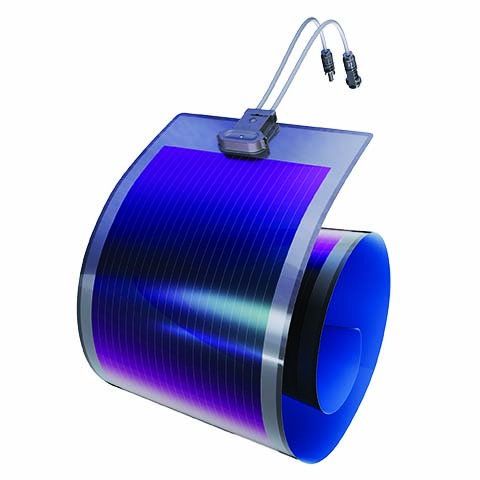
“The key question for us is how fast are we able to provide enough solar films for demand? We are working hard to improve the efficiency and cost to make them even more attractive.”
He expects Heliatek films to eventually be optimized for non-building surfaces.
“Not every fabric of course can generate solar electricity, but we can easily glue our films to existing surfaces and therefore functionalize them,” he adds.
Award-winning achievements
A forerunner in incorporating photovoltaic fabric technology into canopies, military tents, sails, grid-tied long-span structures, charging stations, curtains, building facades, backpacks and clothing, Brooklyn, N.Y.-based Pvilion won two Advanced Textiles Association 2022 International Achievement Awards (IAA) for its development of solar fabric shelters. One recognized Pvilion’s portable, weather-hardy canopy that effectively self-powers equipment, lighting, cell phones, laptops and other gear; the second honored its Hands-Off Expeditionary Tent, which deploys with exceptional speed. Its manufacturing processes call for laminating silicon solar cells onto fabric or integrating them in.
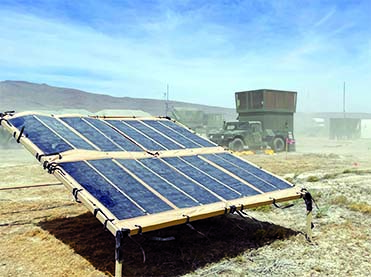
Solar-powered tent
Evansville, Ind.-based Anchor Industries Inc. partnered with Pvilion last year to introduce a solar-powered tent promoted as lightweight, flexible, easy to install, durable and energy efficient.
Buildings get second skins with textiles
In 2022, ASCA®, which manufactures organic photovoltaics in France and Germany, was part of a project that integrated Suntex into 32 organic photovoltaic (OPV) film modules, creating a light and flexible textile. Suntex is a durable, water-resistant textile made from recycled polymer yarns. Designed by Pauline van Dongen, in partnership with Tentech BV, this demonstration project combined the properties of a textile with energy-harvesting potential. The possibility exists for it to be used as a cladding material on facades for new and renovated buildings. It could also be applied to glazing to provide solar protection. Suntex has the ability to make buildings more energy efficient and brings completely new aesthetic qualities such as color, transparency and texture.
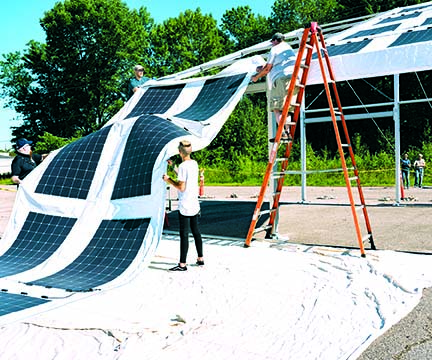
Electro-Yarn
New York-based Marubeni America Corp. makes Electro-Yarn, a solar-powered, heat-generating product made of polyester multifilament coated with carbon nanotubes. Solar energy is gathered via woven-in Sphelar® solar cells.
Thin, lightweight and flexible
At French startup Solar Cloth, sales representative William Borderie reports on the advent of CIGS-cell solar panels (built with copper, indium, gallium and selenium) that have a near 18% efficiency—close to that of silicon panels. The thin, ultra-flexible, lightweight panels can be tailor-made to affix (just like fabric) to vehicles, buildings, tunnels, tents, boats and other objects, using glue, sewing, welding or other means. Advertised as unbreakable and resistant to microcracks, shock and shadow, they can be rolled up for transport and generate power for upward of 20 years. Solar Cloth panels can be fixed on fabric or light structures without risks of cracks/microcracks or the need for an air gap to cool down the panels.
The firm just invested close to $1 million in a factory expansion so that it can launch wide-scale production near Cannes this year.
“We spent many years in R&D to find the right materials and the right way to create such panels,” says Borderie. “The price will remain higher than regular silicon panels, but it’s not a direct competitor; it’s an alternative when regular panels are not a viable option.”
Solar Cloth’s international client roster already includes the French Army, Renault/Volvo, Huttopia and Richel/Toutabri. Borderie expects more applications this year on storage tunnels, greenhouses and “light” buildings constructed of metal
and textiles.
“Demand is growing fast, as the price of energy is not stable,” he explains. “And many customers are willing to have a source of energy with low carbon emissions.”
Borderie predicts the start of widespread use of solar-powered
cars by 2030, closely followed by trucks, boats, tents and all buildings—including those that can’t use regular solar panels.
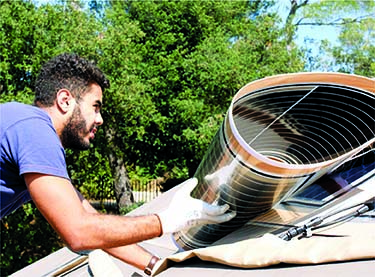
Other energy-producing fabrics to watch
• Baltimore, Md.-based Materic produces the electrospun nanofiber PiezoYarn™ that behaves like nylon yarn but generates a small, non-storable electric output when stretched or twisted. It can be woven or knitted on standard industrial equipment and can provide health and/or athletic data for wearers. Business manager Colin Harmer says corporate interest may make PiezoYarn commercially viable over the next several years.
“What hasn’t been explored is that this can be used to detect vibrations, so if there’s a high enough frequency, there could be
an outlook in power generation,” he adds.
• Pacific Palisades, Calif.-based Hologenix LLC has created CELLIANT®, a blend of natural minerals embedded into recycled polyester, nature-based viscose and other carriers that transforms the wearer’s body heat into immediate full-spectrum infrared energy. Research shows that energy can promote local circulation and cell oxygenation, regulate body temperature and improve recovery from physical activity.
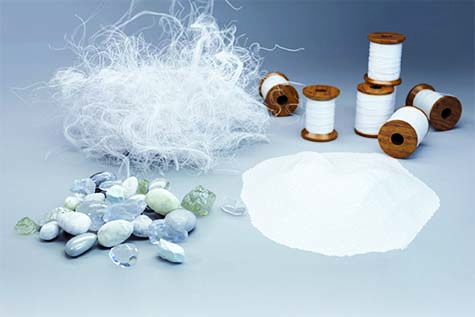
Target markets, according to CEO Seth Casden, include those seeking better sleep, athletes or anyone with daily physical demands who stands to benefit from improved blood flow and faster recovery. The 20-year-old company has published 10 studies in its quest to validate CELLIANT technology and its benefits. Major brand partnerships include Under Armour, Sunlighten Saunas, Bear Mattress and Medline’s CURAD, with hundreds of different products across dozens of brand partners and different categories.
• Brooklyn, N.Y.-based Nextiles sews flexible circuitry into fabrics that can measure biometric and biomechanics data such as direction, speed, distance, force, bending, stretching, velocity and/or pressure.
• Pinole, Calif.-based Eeonyx Corp. creates fabrics that generate warmth via “resistive heating” that work surface-wide without wires or circuitry. It’s also working on thin films that create heat after being printed or applied to surfaces.
• Gastonia, N.C.-based Burlan Manufacturing makes woven fabrics that incorporate electric conductivity into its structures.
Michelle Miron is a freelance writer based in Hugo, Minn.
SIDEBAR: The race to viability
As a consultant to multiple U.S. organizations striving to produce better solar fabrics, Dr. Jack Martin, a professor in the Department of Sustainable Technology and the Built Environment at Appalachian State University in Boone, N.C., says many are competing to be the first to release commercially viable versions. For example, he’s now working with several firms to develop thin solar films that can generate power after being painted onto products.
Eventually, he says, power-generating cells will be built right into the fibers of clothing and other textiles and will power themselves using both indoor and outdoor light.
“A tarp type of material to cover structures with a film, or woven fabric of silicon fiber thread, opens countless opportunities for application,” he says, pointing to key products like rainflys, awnings, sails or even wings.
Other promising areas of PV study, he says, include the nano glass fibers now used for communications infrastructure. Because such fibers can be tied into knots without breaking, they could be successfully incorporated into fabric.
He also believes biotechnology can be used to create solarized surfaces that mimic cells, skin and furs. Someday, he predicts, solar power may be so readily available that students, employees and others will be expected to generate their own portable power to use on location.
“It’s time to think beyond two dimensions,” Martin says. “The future is fabulous. A new field awaits.”
SIDEBAR: Optimization challenges
Efficiency: This refers to the percent of sunlight energy that can be converted via photovoltaics into electricity. Traditionally, silicon-based solar cells have been the most efficient at up to 31%, but they’re rigid, fragile and are considered expensive. Organic polymer-based cells are more flexible
but thus far less efficient.
Flexibility: Traditional photovoltaic panels are made of glass or other rigid materials. Scientists seek alternatives that can bend without breaking and compromising their ability to harvest energy.
Space: The smaller the item, the greater the difficulty in efficiently incorporating the necessary solar components.
Aesthetics: The batteries used to store solar power can be too cumbersome for smaller-sized products.
Expense: The logistics can be complex and prohibitively pricey. “To transfer an R&D concept into a mass-market product in the high-technology environment is a fundamental challenge, which requires expertise, resources and time,” says Stephan Kube, Heliatek.
Battery storage: Manufacturers need solar batteries that are flexible, rechargeable, unobtrusive and affordable enough for mass-market use.
 TEXTILES.ORG
TEXTILES.ORG


